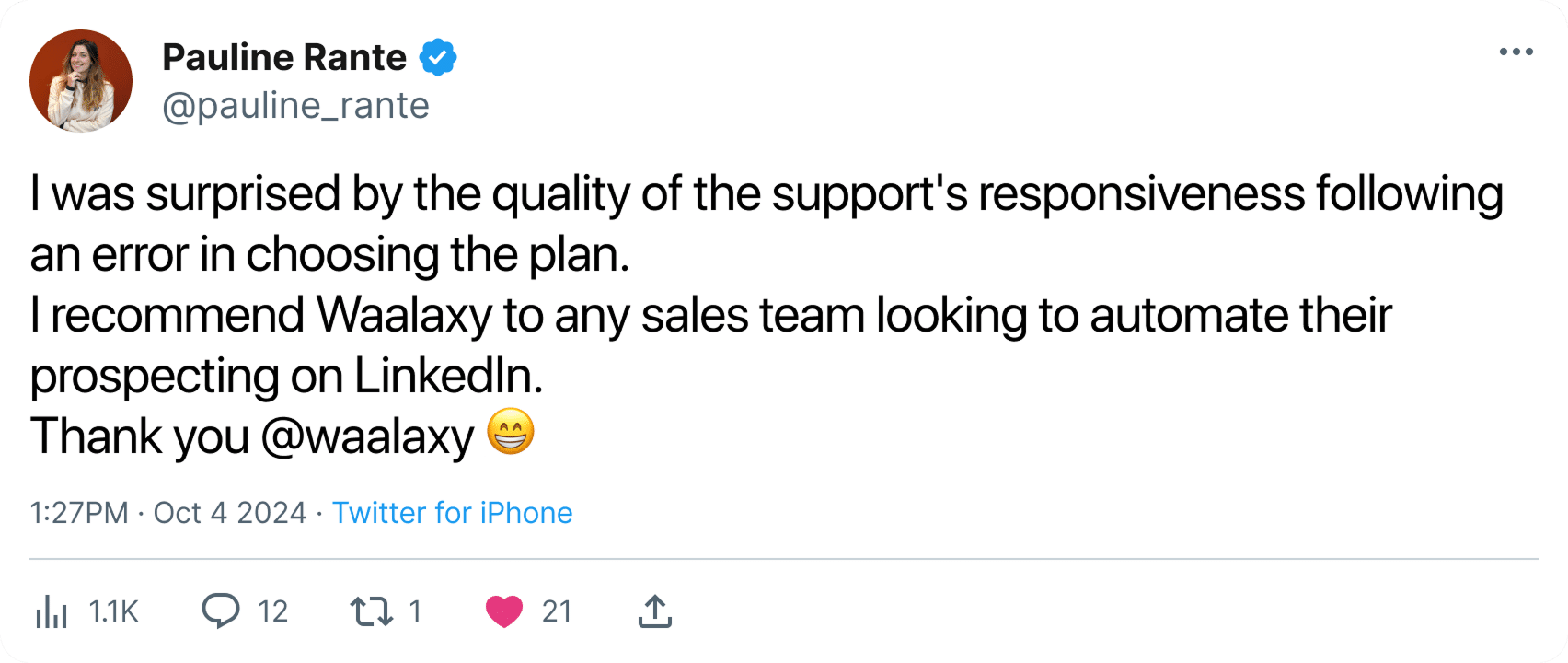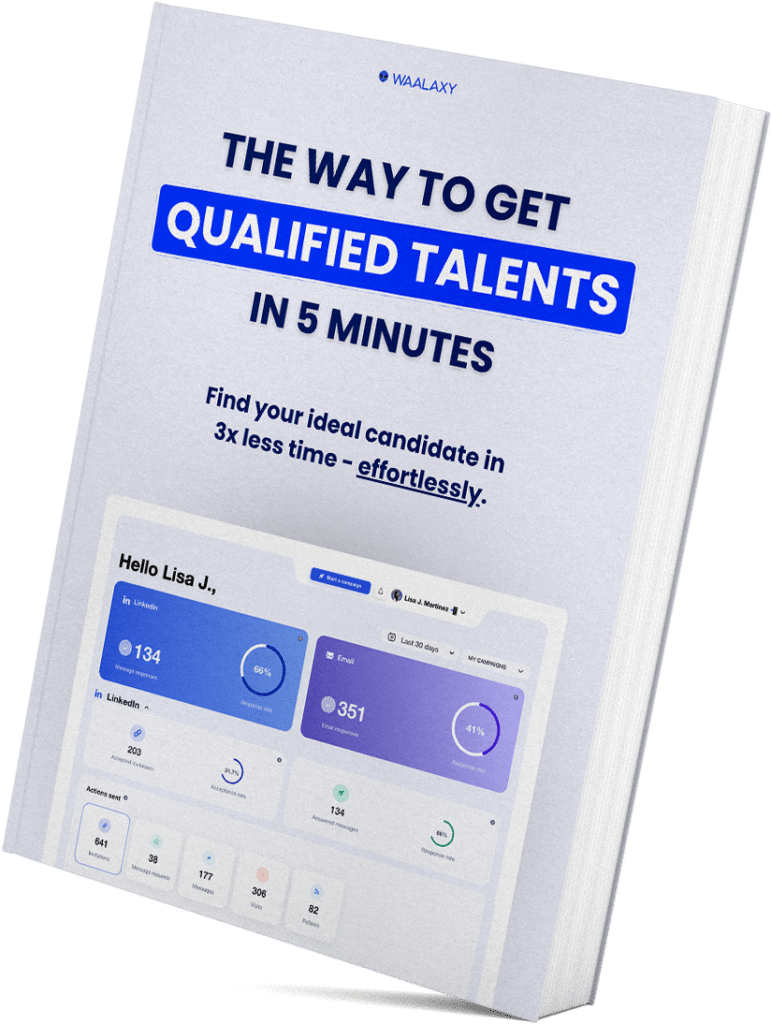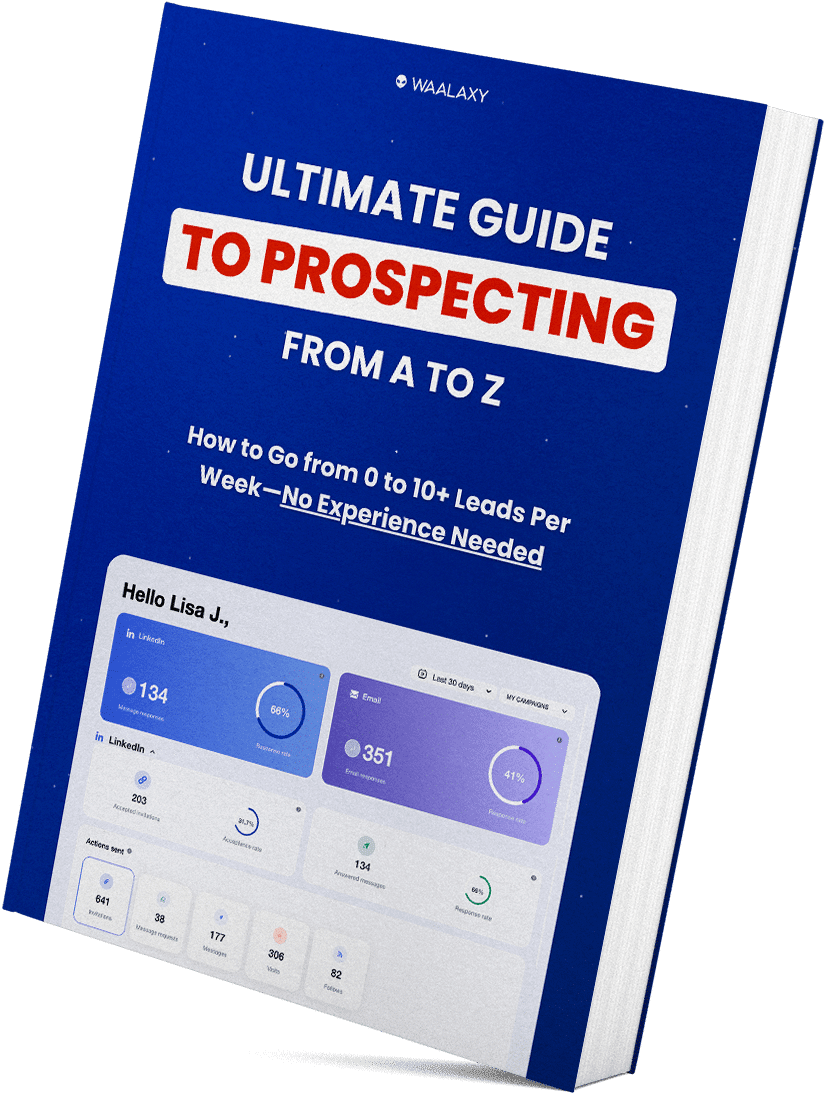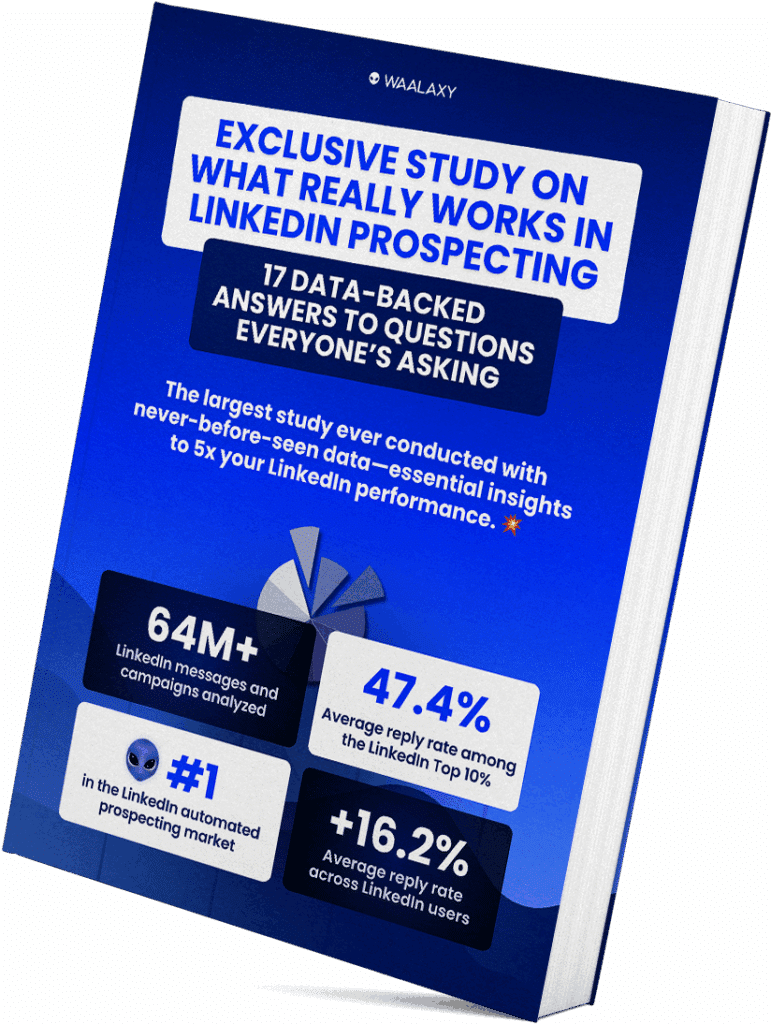- Vibe Marketing Definition : What is it ?
- What are the benefits and limitations of vibe marketing?
- How does Vibe Marketing work?
- 5 steps to Vibe Marketing
- What tools are available for effective vibe marketing AI?
- Examples of B2B vibe marketing
- Case study: Use case Waalaxy, how to amplify Vibe Marketing with automation?
- How about a recap on Vibes marketing?
- Frequently asked questions
You can feel it, and you don’t need numbers to prove it: marketing has become a question of vibe.
Today’s successful brands no longer just sell a product, they sell a mood, an emotion, a sense of belonging. 💫
Vibe marketing is a logical evolution of branding in the age of AI, micro-communities and the attention economy. 👀
In this article, we’ll take a look together at what vibe marketing is, why it’s so seductive, how to implement it concretely into your strategy, and how tools make it possible to transform this “vibe” into real customers. 😎
Vibe Marketing Definition : What is it ?
What is vibe marketing ? Vibe marketing is the art of making your audience feel something even before they read or hear your message ✨
It’s a brand’s ability to generate an immediate emotion — that resonance that makes people say: “I love this brand, I don’t know why, but it speaks to me.”
It’s not just about looks or storytelling, but about the overall atmosphere your marketing team builds — from visuals to tone, interactions, and values. 😇
Today, that creative brainstorm often includes AI-generated ideas and assets, helping brands craft consistent emotions faster and with more precision.
Traditional marketing VS Vibe marketing?
It used to be that brands had to convince.
Today, they have to make people feel.
That’s the difference between traditional marketing, focused on product, proof and performance, and vibe market, which plays on emotion, perception and resonance. And that changes everything 👇
| Aspect | Traditional marketing | Vibe Marketing |
|---|---|---|
| Objective | To promote a specific product, offer or service. The idea is to convince through proof. | Create emotion and connection. The aim is to create a sense of atmosphere and belonging. |
| Message | “This is what we do” Speech centered on features, price or performance. | “Here’s what you’ll feel” Discourse centered on the brand’s vibe, values and personality. |
| Approach | Top-down, structured, often planned well in advance. | Organic, agile and evolutionary. Inspired by cultural trends and the present moment. |
| Support | Advertising campaigns, slogans, TV spots, billboards, commercials. | Experiences, immersive content, social networks, community interaction, coherent visual universe. |
| Temporality | One-off, seasonal campaigns. | Continuous vibe: emotion is maintained over time, at every point of contact. |
| KPIs | Click-through rate, market share, conversion, short-term ROI. | Engagement, attachment, positive sentiment, emotional resonance rate. |
| Example | “The most powerful SUV on the market.” Focused on performance. | “The freedom to drive off without warning.” 🚙✨ Focused on feeling and emotional projection. |
What’s the difference between vibe marketing and classic branding or storytelling?
Branding creates an identity. It’s the brand’s visual and symbolic foundation, its colors, logo, tone and values. It gives shape to who you are, it lays the foundations. ✨
Storytelling, on the other hand, brings this identity to life through a narrative. It’s what connects the brand to its audience: a mission, a promise, a journey, an emotion. Storytelling gives meaning to branding 😉
What about vibe marketing? It’s the emotion that unites the two.
It translates visually and sensorially what branding says, and what storytelling tells.
In other words, vibe marketing transforms your values and your story into a felt experience, through music, light, typography, words, tone, or even the way you respond to a comment… 🧚🏻♀️
Vibe marketing, then, is the fusion of branding (identity), storytelling (meaning) and culture (the emotion of the moment).
What are the benefits and limitations of vibe marketing?
Creating a vibe is interesting… but not without constraints This are the vibe marketing reviews. 👇🏻
Advantages:
- ✨ S trong emotional engagement: Your content elicits a real reaction, not just a scroll.
- 🤓 Perceived authenticity: Audiences sense when a brand is vibing just right.
- 🧚🏻♀️ Differentiation: In a sea of messages, your tone and aesthetic become your signature.
- ❤️🔥 Loyalty: Customers feel connected, not just “targeted”.
Limitations:
- 🤡 Risk of superficiality: Beware of “vibe washing”, that “cool” but meaningless marketing.
- 🛤️ Multi-channel inconsistency: If the vibe changes between LinkedIn, your site… you lose the magic.
- 🧠 Emotional overload: Wanting too much “vibe” can tire the audience.
- 📊 Hard to measure: Without good indicators, it’s hard to know if your vibe is hitting the mark.
How does Vibe Marketing work?
Vibe market is based on a simple mechanism: make people feel before they think.
It’s a strategy that transforms every point of contact – visual, text, interaction – into a coherent emotional micro-experience. ⭐️
1. Visual ambience: the emotional setting
This is the first language of vibe. Colors, typography, lighting, framing, textures, formats… everything contributes to creating a recognizable atmosphere. 🥰
A brand “calm and reassuring” will not choose the same tones or transitions as a brand “rebellious and avant-garde”.
For example:
– Notion: clean visuals, zen interface, neutral tones: vibe “simplicity + focus”.
– Slack: bright colors, fluid graphics: vibe “collaboration + positive energy”.
2. Global mood: the emotion that runs through everything
The mood is the general tone of your communication: fun, nostalgic, futuristic, committed, poetic…
It’s what your audience feels, unconsciously, as they come across you on different channels. 🤓
This is where culture comes in: vibe digital marketing draws on the codes of the moment – memes, music, series, visual trends – to create immediate resonance. A brand that “captures the cultural mood” of the moment creates instant proximity. 😇
3. AI and no-code: enhanced creativity
Vibe marketing wouldn’t be as accessible without today’s tools. Thanks to ai agent and no-code, even a small team can produce fast, well and on a large scale. 🪜
These tools can generate 10 versions of the same vibe (photo, text, music, soundscape…) and test which one resonates best.
4. Speed of execution: test, adjust, publish
Vibe marketing is also about rhythm. 🥁
Successful brands are those that dare to test quickly, listen to emotional signals (reactions, shares, comments), then adjust. ⚖️
Marketing is no longer frozen in quarterly campaigns, but living, adapting to the vibe of the moment. Community managers capture, create and publish in less than 24 hours. 🧚🏻♀️
5 steps to Vibe Marketing
Creating a resonant vibe isn’t a matter of “feeling” or random aesthetics; it’s a thoughtful process that blends strategy and emotion. Here’s how to build a strong, consistent and lasting vibe. 🤩
1. Define the emotion you want to convey
First and foremost, ask yourself: what should your audience feel when they think of your brand?
Calm and confident? Energy and ambition? Inspiration and creativity?
👉 This central emotion will be your emotional compass. 🧭
It will influence your messages, your tone, your visuals and even your sales approach.
➡️ B2B examples:
- Waalaxy inspires proximity and good humor in a world that is often too robotized. 🤖
- HubSpot relies on warmth and trust.
Pick three key adjectives that define your vibe and re-read every piece of content through that prism. If it doesn’t “vibe” with your three words, there’s an adjustment to be made. 🫠
2. Create a coherent visual and verbal universe
Your vibe doesn’t just live in your visuals: it’s expressed in everything you show, say and let others perceive. It has to be recognizable without your logo showing through. 😎
To achieve this 👇🏻 :
- Create a moodboard (Canva, Figma, Pinterest) with your visual inspirations.
- Define your dominant colors and typography that support your central emotion.
- Take care with your tone of voice : warm, quirky, serious, inspiring…
- Harmonize the experience: site, networks, email campaign, customer service…
3. Produce quickly and stay agile
Vibe marketing is all about rhythm. Marketing trends change, expectations shift, and your audience evolves: your creative must keep pace with this dynamic.🏃🏻♀️
The aim is not to be perfect, but to be reactive. Publish, observe, adjust, without locking yourself into overly rigid plans. ✨
Think of your content as “mini-emotional-experiences”. Better a sincere, spontaneous post than a millimeterized but cold campaign. 🙃
Producing fast means creating at the pace of your audience, not at the pace of a retroplanning schedule.
4. Spread your vibe across all channels
A vibe is only valuable if it lives everywhere. What are the tools for effective vibe marketing strategy?
Your tone, visuals and emotions need to be in tune at all touchpoints 👇🏻:
- Social networks(LinkedIn, Instagram, Facebook…).
- Website and blog (wording, design, interactions).
- Prospecting campaigns and emails.
- Customer experience and support.
Think “emotional orchestration”: each channel plays a different note, but the melody remains the same. 🧚🏻♀️
5. Measuring and adjusting emotional resonance
A vibe can be felt, but it can also be measured. It’s an emotional asset to be tracked over time, with concrete indicators. 😉
➡️ Quantitative:
- Engagement rate (likes, shares, comments).
- Click, conversion or response rates.
- Organic growth 📈
➡️ Qualitative:
- ☺️ Tone and emotion of comments.
- Spontaneous feedback (“Your content speaks to me”, “I love your style”).
- Emotional reactions (humor, inspiration, confidence…) 🥹
A strong vibe is judged not just by the number of views, but by the connections it creates.✨

What tools are available for effective vibe marketing AI?
The good news 😎 vibe market is within everyone’s reach.
With the right vibe marketing tools like AI-powered platforms, you can create, distribute, and vibe your world without a giant team or XXL budget.
| Category | Objective | Key tools | What it does for you |
|---|---|---|---|
| Creation & AI | Bring your visual and textual vibe to life | Midjourney, Runway, HeyGen, D-ID, Synthesia, ChatGPT | Create visuals, videos and text aligned with your emotional tone. |
| Prospecting & automation | Turn your vibe into real connections | Waalaxy 💜, Make, n8n, Notion AI | Personalize your messages, automate your sequences and keep communication human on a grand scale. |
| Production & design | Keep a consistent aesthetic across all your media | Canva, Kawaak | Easily create consistent visuals and templates. |
Examples of B2B vibe marketing
Vibe marketing is not limited to consumer brands.
More and moreB2B companies are succeeding in creating a strong emotional connection, combining authenticity, the right tone and visual consistency. Here are two examples! 😎
Waalaxy
Waalaxy has broken the mould of cold, distant B2B. 🧚🏻♀️
Its vibe: human, fun and accessible, prospecting that feels like a conversation between buddies, not an automated sequence.😇
- 📸 LinkedIn Posts: Natural tone, well-measured humor, authentic shares about team life.
- 🎨 Visuals: Colorful, simple, punctuated with emojis and nods to web culture.
- 📮 Emailing : Clear, warm, written as if to a friend, without B2B jargon.
- 💸 Advertisements: Always in tune with the times wordplay, pop references. These Google ADS campaigns surf Internet culture while retaining a professional touch.

This approach creates a real emotional closeness. Prospects feel like they’re talking to humans who understand their codes, not a prospecting tool. 🤖
And the fact that many Waalaxy employees post on LinkedIn reinforces this authenticity : everyone embodies the brand in their own way. 🕺🏻
⚠️ But watch out for consistency : Multiplying voices and styles can also blur the vibe.
Some of the more pronounced posts have sometimes created an overdose or inconsistency of image with the brand, giving different tones depending on the author.

Welcome to the Jungle
Welcome to the Jungle focuses on a different emotion: inspiration and the human touch at work. 💼
Its communication invites you to think, not just click.
- 📹 Videos: Inspiring, focused on meaning, culture and pro/perso balance.
- 🔥 Website: Immersive and warm (yellow), designed as editorial media.

- 🧘🏻♀️ Advertising campaigns: Focus on positive work-related emotions, not performance.
Their vibe, making you want to love what you do an approach that transforms an HR platform into an inspiring brand. 🤩
Case study: Use case Waalaxy, how to amplify Vibe Marketing with automation?
Waalaxy isn’t just an automated prospecting tool: it’s also a vibe marketing gas pedal.
The idea 🤓? To create emotional connections on a grand scale, without losing the human touch that makes all the difference.
1. Identify your emotional niche
Before even talking about automation, you need to know what emotion you want to trigger in your prospects.
Thanks to Waalaxy, you can segment your audiences (by position, sector, tone of communication…) and identify the most suitable vibe: humor, ambition, closeness, curiosity…😌
👉 Your first message should already make you feel it.
2. Engage with authenticity
Waalaxy lets you personalize your messages effortlessly. Between tags, variables and creative sequences, every contact receives a message that rings true, not generic.✨
And with Waami, you can even add more human interaction (audio messages, videos, GIFs) to reinforce that emotional dimension.🤩

3. Automate without dehumanizing
The secret to a vibe that lasts is consistency. Waalaxy’s automation helps you maintain a regular connection – LinkedIn invitations, follow-ups, messages – without losing your natural tone 😉
Each sequence can be calibrated to respect your style and values, not just your KPIs.
4. Measure and refine vibe
Creating a vibe is great. Managing it is even better. With Waalaxy’s performance indicators, you can track your response and click-through rates, or even pinpoint the messages that generate the most emotional interactions. Make your campaigns a real emotional laboratory: test different tones, adjust, then keep what resonates best.❤️🔥

How about a recap on Vibes marketing?
You can feel it without even pulling out the stats: marketing is no longer about the product, it’s about the feeling. 💫
Successful brands no longer just sell offers, they sell emotion, mood, belonging.😉
Vibe marketing isn’t a fad, it’s the natural evolution of branding in the age of AI, micro-communities and authenticity. It’s what allows a brand to create connection before creating need and to continuously optimize how that emotion is felt across every touchpoint. ✨✨
So, rather than trying to convince… make your leads vibrate. 🕺🏻
Frequently asked questions
Is vibe digital marketing strategy right for every brand and every sector?
They sound alike, but they serve different purposes : 👇
- Vibe Coding, on the other hand, is more analytical. It uses AI-powered systems and real-time data to decode emotions, behaviors, and cultural signals, then translates them into actionable marketing insights.
Marketers use AI prompts and emotional data modeling to shape how the vibe should evolve dynamically. 😌 - Vibe Marketing focuses on creating an emotional connection between your brand and audience. It’s about making people feel something through tone, visuals, storytelling, and culture — an AI-powered approach to building authentic resonance and brand consistency.😇
The future of vibe marketing: micro-vibes, AI and immersion, where is this trend headed?
The future of vibe marketing looks set to be even more sensory, personalized and immersive. 🔮
We’re already talking about micro-vibes: ultra-targeted emotions, tailored not just to an audience, but to each individual. Thanks to AI, brands will be able to adjust their visuals, words, sounds or even moods in real time according to the customer’s emotional profile.😌
Immersive technologies such as augmented reality (AR) or virtual reality (VR), meanwhile, will enable users to be immersed in genuine multi-sensory personnal brand experiences: feeling, hearing, interacting with a vibe rather than just looking at it. 👀
Tomorrow, brands will no longer simply broadcast an identity: they will build living, evolving and personalized universes, blending global reach with vibe local marketing, capable of adapting to the consumer’s context, mood and moment in life. 🌐✨
Now you know all about Vibe marketing! 🧚🏻♀️










